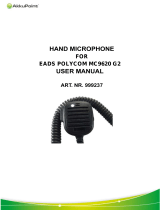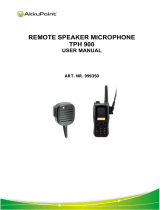Page is loading ...

68015000882-G
*68015000882*
December 2014
EN
© 2014 Motorola Solutions, Inc. All rights reserved.
Mobile Release 14.0
MTP830 S
PRODUCT INFORMATION
MANUAL


Copyrights
The Motorola products described in this document may include copyrighted Motorola computer programs. Laws in
the United States and other countries preserve for Motorola certain exclusive rights for copyrighted computer
programs. Accordingly, any copyrighted Motorola computer programs contained in the Motorola products described
in this document may not be copied or reproduced in any manner without the express written permission of Motorola.
©
2014 Motorola Solutions, Inc. All Rights Reserved.
No part of this document may be reproduced, transmitted, stored in a retrieval system, or translated into any language
or computer language, in any form or by any means, without the prior written permission of Motorola Solutions, Inc.
Furthermore, the purchase of Motorola products shall not be deemed to grant either directly or by implication,
estoppel or otherwise, any license under the copyrights, patents or patent applications of Motorola, except for the
normal nonexclusive, royalty-free license to use that arises by operation of law in the sale of a product.
Disclaimer
Please note that certain features, facilities, and capabilities described in this document may not be applicable to or
licensed for use on a particular system, or may be dependent upon the characteristics of a particular mobile subscriber
unit or configuration of certain parameters. Please refer to your Motorola contact for further information.
Trademarks
MOTOROLA, MOTO, MOTOROLA SOLUTIONS, and the Stylized M Logo are trademarks or registered
trademarks of Motorola Trademark Holdings, LLC and are used under license. All other trademarks are the property
of their respective owners.
European Union (EU) Waste of Electrical and Electronic Equipment (WEEE)
directive
The European Union's WEEE directive requires that products sold into EU countries must have the crossed out
trashbin label on the product (or the package in some cases).
As defined by the WEEE directive, this cross-out trashbin label means that customers and end-users in EU countries
should not dispose of electronic and electrical equipment or accessories in household waste.
Customers or end-users in EU countries should contact their local equipment supplier representative or service centre
for information about the waste collection system in their country.
Open Source Software (OSS) Legal Notices
For details on OSS Legal Notices visit Motorola Online (emeaonline.motorolasolutions.com) or browse the CPS Plus
disc.
3 | Copyrights
| | Send Feedback


Contents
Copyrights........................................................................................................................................ 3
List of Figures.................................................................................................................................. 9
List of Tables.................................................................................................................................. 11
Icon Conventions........................................................................................................................... 13
Chapter 1: Product Overview............................................................................... 15
MTP830 S Overview...........................................................................................................................................15
Specification............................................................................................................................................16
Ordering Options for Radios and Features..........................................................................................................17
Dongle Enablement – Software Enablement Kits...............................................................................................17
Ordering a Software Enablement Kit.................................................................................................................. 18
Radio Ordering....................................................................................................................................................18
Chapter 2: Services and Features.........................................................................19
System Support................................................................................................................................................... 19
Trunked Mode Operation.................................................................................................................................... 19
Direct Mode Operation........................................................................................................................................20
Numbering and Addressing.................................................................................................................................20
Dialing Methods..................................................................................................................................................21
Individual Dialing....................................................................................................................................21
Unified Address Book.........................................................................................................................................21
Call History......................................................................................................................................................... 22
Group Call........................................................................................................................................................... 22
Programmable Talkgroups...................................................................................................................... 22
Talkgroup Folders................................................................................................................................... 23
Talkgroup Selection................................................................................................................................ 23
Favorite Folders.......................................................................................................................................24
Talkgroup Blind Operation..................................................................................................................... 24
Receive-only Talkgroups........................................................................................................................ 24
Non-Selectable Talkgroups..................................................................................................................... 24
Talk Time Limit...................................................................................................................................... 24
Group Call Reception..............................................................................................................................24
Talkgroup Scanning................................................................................................................................ 24
Priority Monitor.......................................................................................................................................25
Announcement Talkgroup.......................................................................................................................25
Broadcast Call Initiated by User............................................................................................................. 26
Timed Talkgroup Change........................................................................................................................26
Broadcast Call......................................................................................................................................... 26
Announcement Call.................................................................................................................................27
PTT Double Push.................................................................................................................................... 27
PTT Queue.............................................................................................................................................. 27
Talking Party Identification.....................................................................................................................27
Call Ownership........................................................................................................................................27
Transmission During Group Call............................................................................................................ 28
Call Restoration.......................................................................................................................................28
Temporary Group Address......................................................................................................................28
Late Entry................................................................................................................................................28
User Initiated Group Attachment............................................................................................................ 28
SwMI Initiated Group Attach/Detach..................................................................................................... 29
Contents | 5

Private Call..........................................................................................................................................................29
Simplex Private Call................................................................................................................................29
Duplex Private Call................................................................................................................................. 29
Talk Time Limit...................................................................................................................................... 30
Call Restoration in Private Call...............................................................................................................30
Call Modification.................................................................................................................................... 30
Assistance Call........................................................................................................................................ 30
DMO Individual Call Presence Check.................................................................................................... 30
DMO Individual Only Talkgroups..........................................................................................................31
Phone Call........................................................................................................................................................... 31
Phone Call Initiation................................................................................................................................31
Phone Call Reception.............................................................................................................................. 31
Call Restoration in Phone Call................................................................................................................ 31
Emergency Operations........................................................................................................................................ 32
Emergency Group Call............................................................................................................................32
Non-Tactical Emergency.........................................................................................................................32
Emergency Individual Calls (Private or MS-ISDN)............................................................................... 33
Emergency Alarm....................................................................................................................................33
Emergency SDS Status............................................................................................................................33
Emergency Hot Microphone................................................................................................................... 33
Alternating Hot Microphone................................................................................................................... 33
Silent Emergency Mode.......................................................................................................................... 34
Invisible Emergency................................................................................................................................34
Disaster Alert...........................................................................................................................................34
Short Data Services............................................................................................................................................. 35
Status Messages.......................................................................................................................................35
Shadow Groups (Address Bundle)..........................................................................................................36
Text Messages......................................................................................................................................... 36
SDS Messages Concatenation.....................................................................................................37
Immediate Text Messages.......................................................................................................................38
Home Display Text Message.................................................................................................................. 38
Predefined Templates (ATS Entry Prompt)............................................................................................ 38
SDS Air Interface Aspects...................................................................................................................... 38
SDS Encryption.......................................................................................................................................38
Store and Forward................................................................................................................................... 39
SDS Receive Failure Notification........................................................................................................... 39
Security Services................................................................................................................................................. 39
Terminal Equipment Identity.................................................................................................................. 40
PIN/PUK User Authentication................................................................................................................ 40
Authentication......................................................................................................................................... 40
Air Interface Encryption..........................................................................................................................40
Clear Radios (Class 1).................................................................................................................41
Static Cipher Key Encryption (Class 2)...................................................................................... 41
Derived Cipher Key and Common Cipher Keys Encryption (Class 3).......................................41
Group Cipher Keys Encryption (Class 3G).................................................................................42
Over-the-Air-Rekeying............................................................................................................... 42
Encryption Mobility.................................................................................................................... 43
Encryption MMI..........................................................................................................................43
AIE Key Storage......................................................................................................................... 43
Deleting User Keys..................................................................................................................... 43
Secure DMO............................................................................................................................................44
End-to-End Encryption............................................................................................................................44
SIM Security............................................................................................................................................45
Radio Disable/Enable..............................................................................................................................45
Radio Permanent Disable........................................................................................................................ 46
Radio Permanent Disable v2................................................................................................................... 46
6 | Contents

High Assurance Boot...............................................................................................................................47
Packet Data..........................................................................................................................................................47
Voice and Data Support.......................................................................................................................... 48
Packet Data IP Addressing......................................................................................................................49
PD User Authentication...........................................................................................................................49
TETRA Network Protocol 1................................................................................................................................49
TNP1 IP Addressing................................................................................................................................50
Mobility Services................................................................................................................................................ 50
Main Control Channel Frequencies.........................................................................................................50
Control Channel Selection.......................................................................................................................51
Multi-System Operation..........................................................................................................................51
Registration............................................................................................................................................. 52
Call Roaming...........................................................................................................................................52
Seamless Handover................................................................................................................................. 53
Air Interface Migration........................................................................................................................... 53
Dynamic Air Interface Migration............................................................................................................54
Any Networks..........................................................................................................................................54
Congested Cell Handling.........................................................................................................................54
Subscriber Class...................................................................................................................................... 55
Subscriber Class by Talkgroup................................................................................................................55
RF Power Toggle.....................................................................................................................................55
Local Site Trunking.................................................................................................................................56
Supplementary Services...................................................................................................................................... 56
Dynamic Group Number Assignment.....................................................................................................56
Ambience Listening................................................................................................................................ 58
Pseudo Power-Off................................................................................................................................... 58
Preemptive Priority Call..........................................................................................................................58
Transmit Inhibit Mode.............................................................................................................................58
Calling Line Identification Presentation..................................................................................................59
Talking Party Identification.....................................................................................................................59
DTMF Overdial.......................................................................................................................................60
Universal Time Display...........................................................................................................................60
Man Down...........................................................................................................................................................60
Man Down (Operation)........................................................................................................................... 60
Repeater Mode.................................................................................................................................................... 61
DMO Gateway and Repeater Communication....................................................................................................61
Communication through Repeaters.........................................................................................................62
Communication through Gateways.........................................................................................................62
SDS Remote Control...........................................................................................................................................63
Call-Out...............................................................................................................................................................64
Call-Out Interactions............................................................................................................................... 65
Call-Out Templates................................................................................................................................. 65
GPS Location Service......................................................................................................................................... 65
GPS Military Grid Reference System..................................................................................................... 67
GPS Different Location Displays............................................................................................................68
Chapter 3: Man-Machine Interface..................................................................... 69
Controls, Indicators and Related Features...........................................................................................................69
LED Indications...................................................................................................................................... 69
Controls and Indicators........................................................................................................................... 70
Software Keypad..................................................................................................................................... 72
Keypad Lock........................................................................................................................................... 73
Automatic Keypad Lock......................................................................................................................... 73
One-Touch Button Feature......................................................................................................................73
Display.................................................................................................................................................................75
Contents | 7

Status Icons..............................................................................................................................................76
Idle Display............................................................................................................................................. 79
Configurable Idle Screen.........................................................................................................................80
Display Features......................................................................................................................................80
Languages Supported.............................................................................................................................. 81
Tones................................................................................................................................................................... 82
Dual Microphones............................................................................................................................................... 83
Speaker/Earpiece................................................................................................................................................. 84
Volume Adjustment Mode.................................................................................................................................. 84
Accessory Setup.................................................................................................................................................. 84
Audio Features.................................................................................................................................................... 84
Audio Profiles..........................................................................................................................................85
Transmit Automatic Gain Control...........................................................................................................85
Howling Suppression.............................................................................................................................. 85
Test Page............................................................................................................................................................. 85
Radio Info............................................................................................................................................................87
Hardware Test..................................................................................................................................................... 87
Appendix A: Service Information – EIA.............................................................. 89
Appendix B: Service Information – AME............................................................ 91
Appendix C: Service Information – Americas..................................................... 95
Glossary.......................................................................................................................................... 99
8 | Contents

List of Figures
Figure 1: MTP830 S .......................................................................................................................................................15
Figure 2: Trunked Mode Operation ................................................................................................................................19
Figure 3: Direct Mode Operation ................................................................................................................................... 20
Figure 4: Talkgroup Tree ............................................................................................................................................... 23
Figure 5: Voice and Data End to End Encryption ..........................................................................................................44
Figure 6: SDS remote Control Overview .......................................................................................................................63
List of Figures | 9

10 | List of Figures

List of Tables
Table 1: General Technical Specification ...................................................................................................................... 16
Table 2: RF Specification ...............................................................................................................................................16
Table 3: GPS Specification ............................................................................................................................................ 17
Table 4: Dialing Scheme ................................................................................................................................................ 21
Table 5: Security Features Required Per Security Class ................................................................................................40
Table 6: Voice-Data Interaction Modes ......................................................................................................................... 48
Table 7: Packet Data IP Addressing ...............................................................................................................................49
Table 8: TNP1 IP Addressing ........................................................................................................................................ 50
Table 9: GPS Triggers ....................................................................................................................................................67
Table 10: Different Location Displays ...........................................................................................................................68
Table 11: LED Indications ............................................................................................................................................. 69
Table 12: Controls and Indicators .................................................................................................................................. 70
Table 13: One-Touch Button Features ........................................................................................................................... 73
Table 14: Display ........................................................................................................................................................... 75
Table 15: Colors of the Soft Key Area ...........................................................................................................................75
Table 16: Status Icons .................................................................................................................................................... 76
Table 17: Languages Supported .....................................................................................................................................81
Table 18: Radio Tones ................................................................................................................................................... 82
Table 19: Speaker Control Key Behavior ...................................................................................................................... 83
Table 20: Service Information — Telephone Numbers to EIA Integrated Call Center .................................................89
Table 21: Service Information – Telephone Numbers and Addresses of the Asia and Pacific Motorola Centers ........ 91
Table 22: Service Information – Telephone Numbers and Addresses of Latin America Radio Support Centers .........95
Table 23: Service Information – Telephone Numbers and Addresses of Latin America Motorola Centers ................. 95
List of Tables | 11

12 | List of Tables

Icon Conventions
The documentation set is designed to give the reader more visual clues. The following graphic icons are used
throughout the documentation set. These icons and their associated meanings are described below.
Danger: The signal word DANGER with the associated safety icon indicates information that, if
disregarded, will result in death or serious injury.
Warning: The signal word WARNING with the associated safety icon indicates information that, if
disregarded, could result in death or serious injury, or serious product damage.
Caution: The signal word CAUTION with the associated safety icon indicates information that, if
disregarded, may result in minor or moderate injury, or serious product damage.
Caution: The signal word CAUTION may be used without the safety icon to state potential damage or
injury that is not related to the product.
Important: IMPORTANT statements contain information that is crucial to the discussion at hand, but is
not CAUTION or WARNING. There is no warning level associated with the IMPORTANT statement.
Note: NOTE contains information more important than the surrounding text, such as exceptions or
preconditions. They also refer the reader elsewhere for additional information, remind the reader how to
complete an action (when it is not part of the current procedure, for instance), or tell the reader where
something is located on the screen. There is no warning level associated with a note.
Suggestion: SUGGESTION indicates a recommendation or tip from Motorola that does not require to be
followed, but might be helpful. There is no warning level associated with SUGGESTION.
13 | Icon Conventions
| | Send Feedback


Chapter
1
Product Overview
MTP830 S Overview
Motorola MTP830 S TETRA portable terminals are the ideal choice when working in extreme conditions. These
terminals deliver premium performance, while combining louder audio and enhanced ergonomics with simplified
controls, allowing fire fighters and other first responders to focus on the task at hand.
Figure 1: MTP830 S
Enlarged rotary knob allows better radio glove-friendly functionality, thus allowing easier control talkgroup and
volume settings.
Operating a radio under protective clothing can be challenging. The MTP830 S can safely inter-operate with a wide
range of specialist audio and push-to-talk equipment.
Man Down detector allows an emergency alert signal to be triggered at your control room when the radio exceeds
preset motion timer and tilt angle thresholds.
The MTP830 S can be configured to send location reports when the emergency button is pressed – helping control
room staff coordinate a response more efficiently.
The MTP830 S automatically adjust audio settings based on pre-loaded profiles for detected accessories. It also
enables selecting the best audio profile for different working environments.
The combination of a highly sensitive RF receiver and transmission power that is adjustable to 1.8W provides
extended operational range.
15 | Product Overview
| | Send Feedback

Specification
Table 1: General Technical Specification
Parameter Value
Dimensions HxWxD mm 125 x 59 x 36 (with standard 1850 mAh battery)
Weight g
174 radio only
234 with 1850 mAh battery
Battery Operating Life (Time Expect-
ed)
05/05/90
05/35/60
Talk Time
Class 4 (1 W)
> 23 hr
> 17 hr
3.5 hr
Class 3L (1.8 W for 380–430 MHz
only )
> 20.5 hr
> 15.5 hr
2.5 hr
Color Display 130 x 130 pixel screen size with 65536 vivid colors flip screen and large text
options
Talkgroups - TMO
4000 Entries (up to 2048 entries in one folder)
2048 Unique entries
Talkgroups - DMO 1024 Entries
Folders - TMO 256
Folders - DMO 128
Favorite Groups 384 (3 Favorite Groups folders containing up to 128 entries each)
Contact List
1000 Contacts
up to six entries (numbers) per contact
Max. 2000 entries
Text Message List
100 Short and 20 Long Messages for Outbox
100 Short and 10 Long Messages for Inbox
Status List 400 Entries
Country Code/Network Code List 100 Entries
Scan List 40 Lists of 20 Groups
Operating Temperature °C -30 to +60
Storage Temperature °C -40 to +85
Humidity ETSI 300 019-1-7 class 7.3E
Dust and Water IP54 per IEC 60529
Shock (Mechanical), Drop & Vibra-
tion
ETSI 300-019 1-7 class 5M3
Table 2: RF Specification
Parameter Value
Frequency Bands MHz 380–430 MHz
Table continued…
16 | Product Overview
Send Feedback | |

Parameter Value
RF Channel Bandwidth kHz 25
Transmitter RF Output Power W 1 (Class 4) and 1.8 (Class 3L 1.8 W)
RF Power Control 3 Steps of 5 dB
RF Power Level Accuracy +/-dB 2
Adaptive Power Control Per EN 300 392-2
Receiver Class A and B
Receiver Static Sensitivity dBm -112 minimum (-115 typical)
Receiver Dynamic Sensitivity dBm -103 minimum (-107 typical)
Table 3: GPS Specification
Parameter Value
Simultaneous Satellites 12
GPS Antenna
Helical - integrated into TETRA Antenna
Sensitivity -152 dBm / -182 dBW
Accuracy (Measured at -137 dBm)
5 meters - 50% probable
10 meters - 95% probable
Protocols ETSI LIP & Motorola LRRP
Note: This specification may be subject to change without further notice. All product features are subject to
infrastructure support. Selected features are subject to optional software upgrade.
Ordering Options for Radios and Features
TETRA terminals are only available to accredited channel partners who are advised of the discount structure applied
to these products.
Software options can be ordered and enabled in three ways:
• You can have them enabled at the Distribution Centre (DC).
• If you have iTM, you can enable them with a license.
• You can order by using a dongle.
Dongle Enablement – Software Enablement Kits
Each software enablement kit ordered provides one dongle for the customer with a specific number of counters set
according to the number of software options ordered. This kit number is applicable to both new orders or existing
fielded terminals which require software enablement.
The features are enabled at the same time the customer programs the radio. The enablement for all the selected
features is performed in one operation.
Product Overview | 17
| | Send Feedback

Ordering a Software Enablement Kit
Procedure:
1 Order the standard software enablement kit (main kit) – GM0127.
2 Add software feature options.
Note: You can select more than one feature for each main kit.
3 Order a quantity equaling the number of models requiring an option.
Radio Ordering
Procedure:
1 Order the main radio model.
2 Order options from each of the following categories:
• Software Selling Features
• Customer Programming Software
• Integrated Terminal Management
• Accessories
Note: Export controls apply when ordering encryption.
18 | Product Overview
Send Feedback | |

Chapter
2
Services and Features
System Support
The radio operates on the Dimetra IP 5.x, 6.x, 7.x and 8.x releases and Dimetra IP Compact. It also operates on
previous versions of Dimetra — from Release 3.8 and on.
The radio is designed to operate optimally on the Dimetra IP system. The radio operates properly on all SwMIs that
comply with the following IOP TIP documents:
• TIP-Core TTR 001-01, TIP — Part 1: Core.
• TIP SDS TTR 001-02, TIP — Part 2: Short Data Service.
• TIP Auth TTR 001-04 TIP — Part 4: Authentication.
• TIP PD TTR 001-05 TIP — Part 5: Packet Data.
• TIP-SS-AL TTR 001-09 TIP — Part 9: Ambience Listening.
• TIP AIE TTR 001-11 TIP — Part 11: Air Interface Encryption.
• TIP Disable TTR 001-13 TIP — Part 13 - Enable/Disable.
Trunked Mode Operation
Trunked Mode Operation requires the switching and management infrastructure. This operation mode enables various
voice and data communication types (for example, group calls, short data service messages) and access to the
infrastructure-related features (for example, packet data).
Figure 2: Trunked Mode Operation
19 | Services and Features
| | Send Feedback

Direct Mode Operation
Direct Mode Operation is a mode of simplex operation where radios communicate directly.
Figure 3: Direct Mode Operation
Numbering and Addressing
Each radio has a TETRA ITSI used for addressing the radio over the air interface. However, it is undesirable to
require you to enter a long number to address another radio. To this end, a set of short number schemes can be used.
Alternatively, the radio can be provisioned to treat a short number as an SSI. This scheme can be refined to allow
short dialing within a fleet by combining the ID entered with the radio own SSI.
If the radio is provisioned to treat a short number as a TETRA Short Subscriber Identity (SSI), and the number
entered is less than seven digits, the radio own identity is combined with the number entered to produce the actual
ISSI. Using this scheme, an ISSI can be comprised of a fleet number part and a member part.
The radio own ISSI is used for determining the leading digits for the digits omitted as in the following scenario:
1 The radio has the following ID: 1234567
2 You enter: 890
3 The SSI sent is: 1234890
The following services can use the short SSI for identification for both the called and the calling party:
• Duplex private call
• Simplex private call
• Group call
• Mobile status
• Short data bearer service
• Text message service
Regardless of the short addressing scheme used, if you are provisioned with the capability of entering a real TETRA
ISSI and you enter an ID of seven digits, the number is interpreted as a real TETRA ISSI.
20 | Services and Features
Send Feedback | |
/




